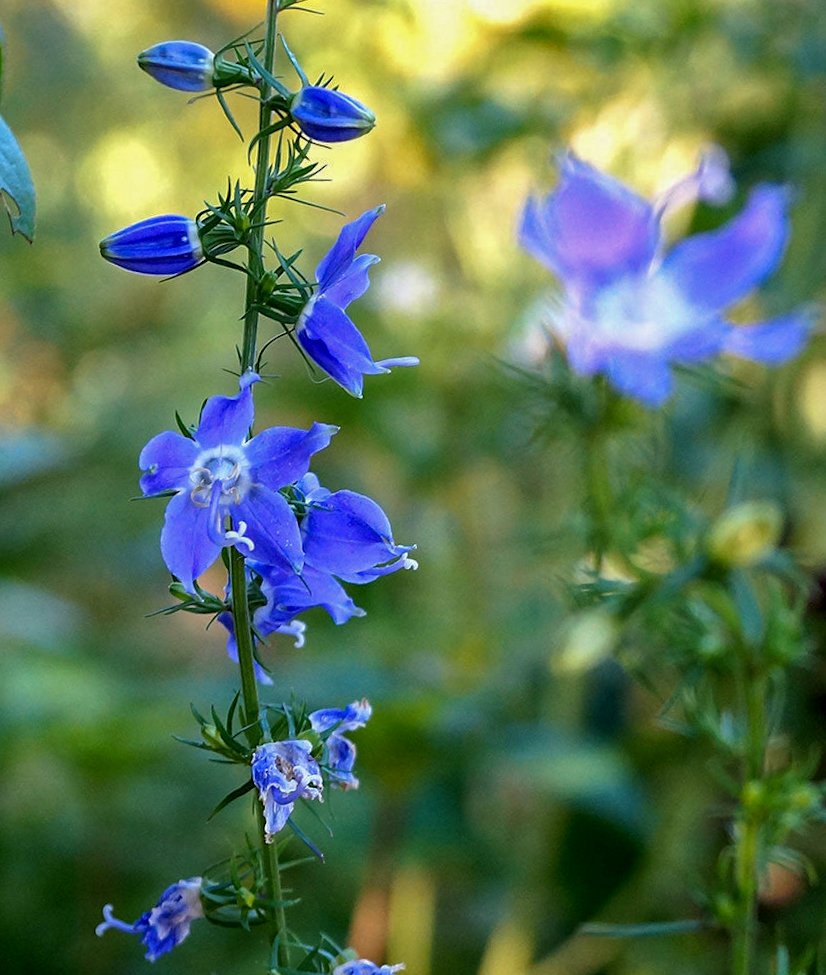 Image 1 of 6
Image 1 of 6

 Image 2 of 6
Image 2 of 6

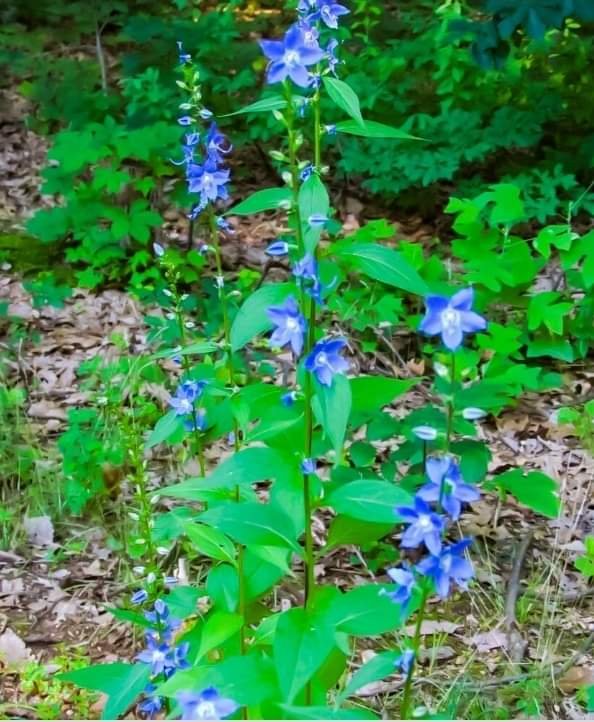 Image 3 of 6
Image 3 of 6

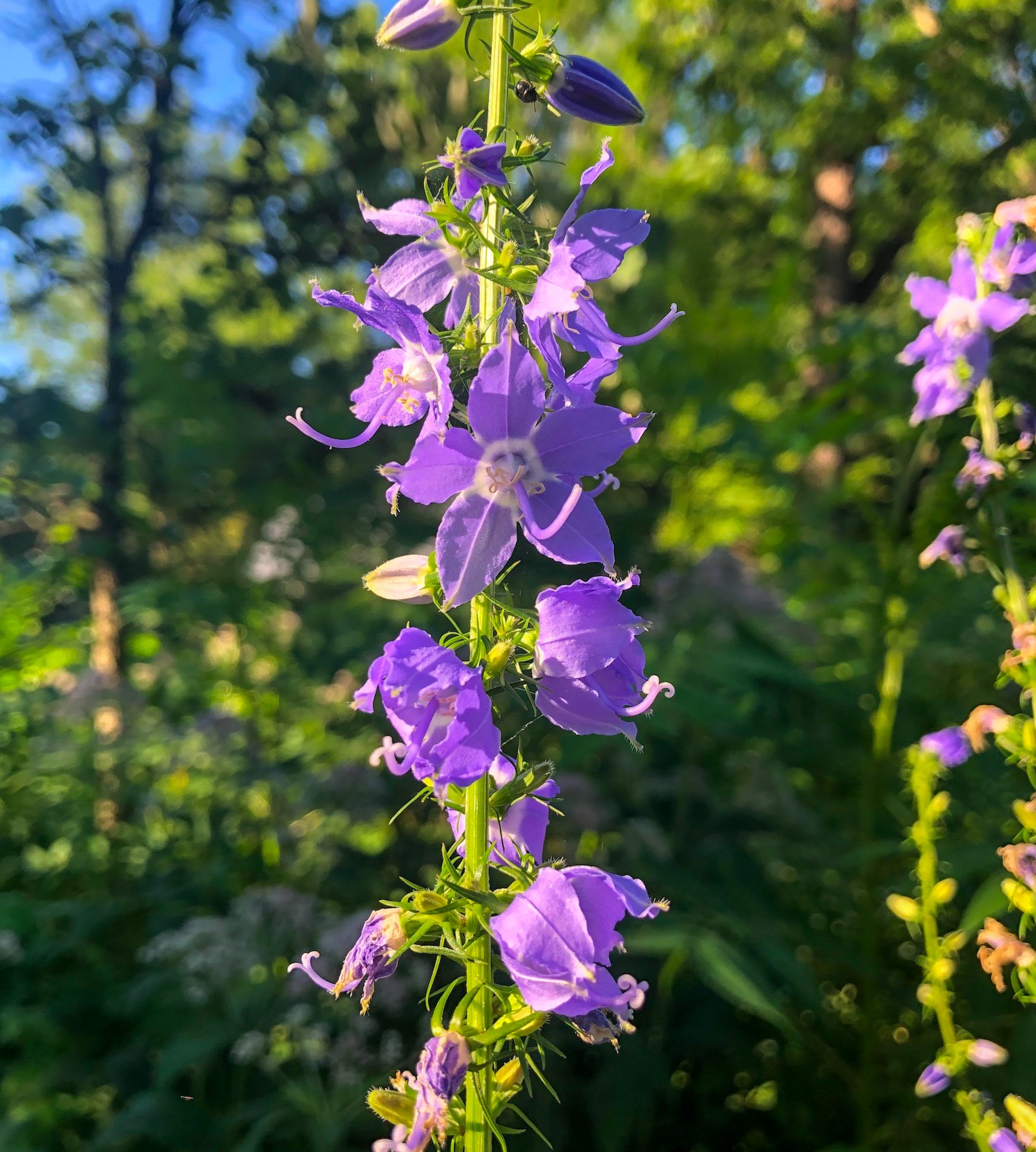 Image 4 of 6
Image 4 of 6

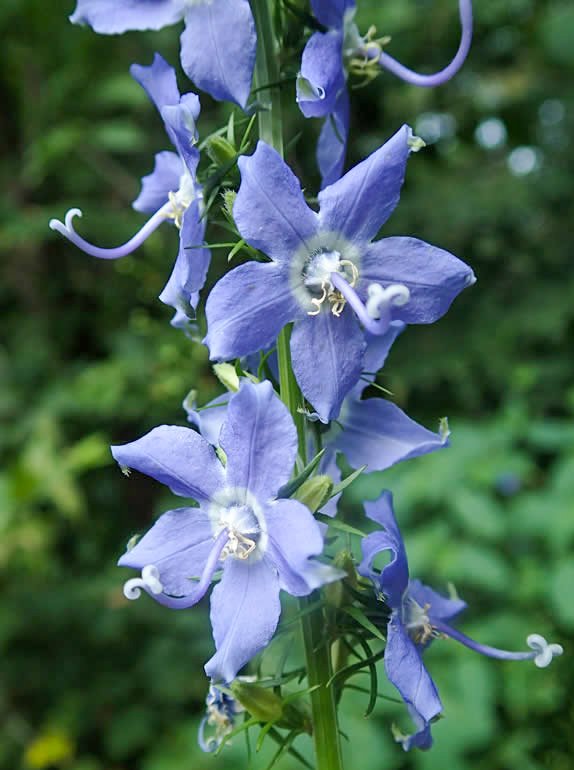 Image 5 of 6
Image 5 of 6

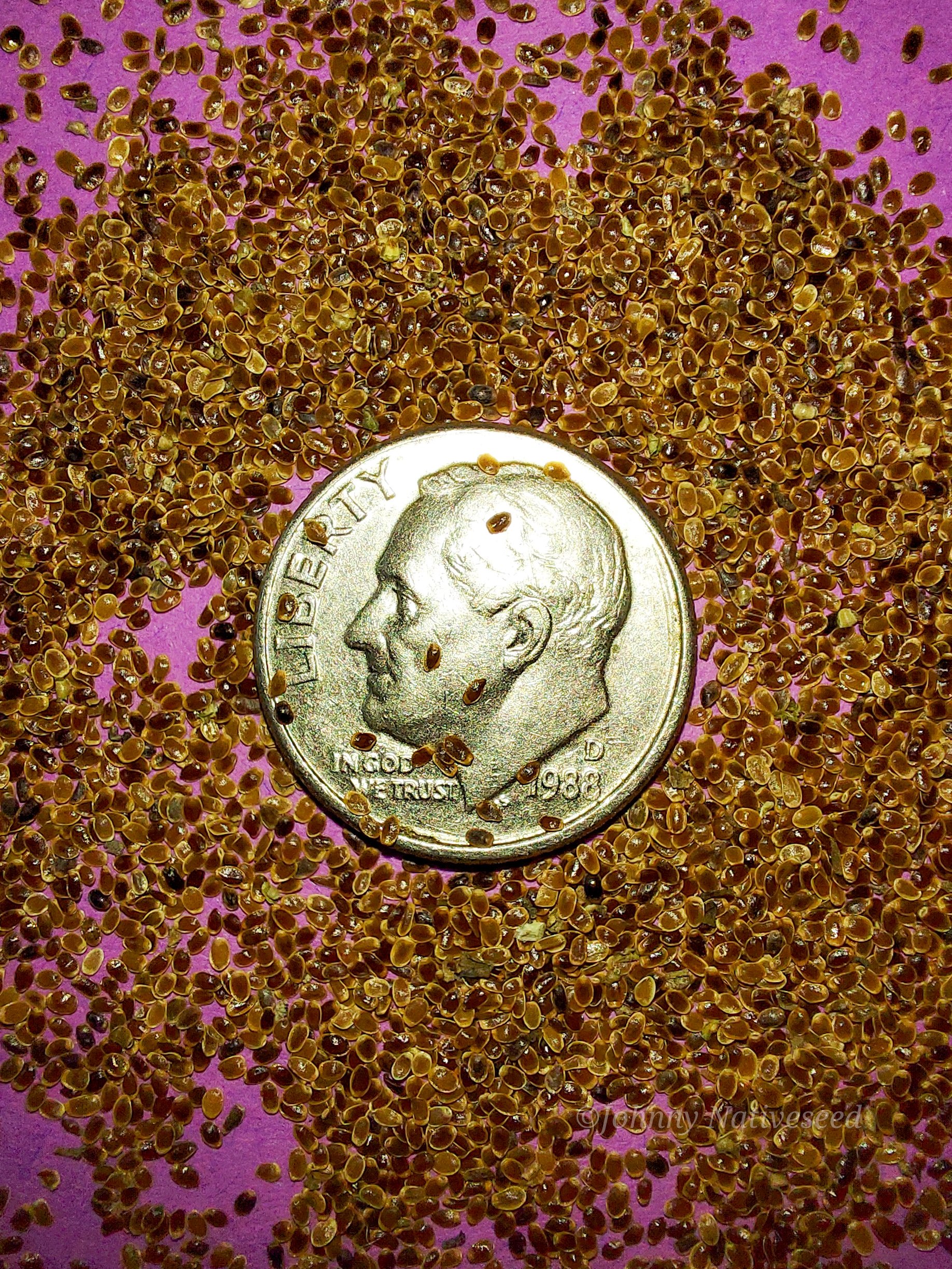 Image 6 of 6
Image 6 of 6

American Bellflower (Campanula americana)
American Bellflower (Campanula americana)
Campanula americana, most commonly called the American Bellflower, or Tall Bellflower is a bellflower native to Eastern and Midwestern North America.
Tall bellflower flowers ring through in a stunning light blue to violet with a pale white ring in the the throat, which primarily bloom in July and August, but can bloom well into October if conditions are favorable.
Campanula americana, is an unusual bellflower in that its flowers are more flat. Its flowers are approximately 1" across with pistils having a recurved style with a three lobed anther and each flower having 5 stamen, 5 petals, and 5 sepals each. The ovaries develop into 5 angled flat topped seed pods.
American Bellflowers can either be annual or biennial within a spectrum of life-history with some seed germinating in the fall, producing annual plants and then later spring-germinating seeds producing biennial plants! It’s a genius strategy!
Long-tongued bees are generally American Bellflowers primary pollinators, including Megachile campanulae, but also halictid bees, butterflies, and skippers can act as pollinators on! American Bellflower typically does not self-pollinate.
American Bellflowers can be found growing from the upper Midwestern Great Lakes region, all the way south to Florida, and from the the Dakotas east all the way to New York!
American Bellflowers thrive in partial shade and can be found growing in the dappled shade along woodland edges, in open woods, shaded meadows, gentle streambanks and even ditches.
This plant is listed as present but rare in several counties of the states of New York, South Carolina, and Louisiana.
Plant Details
USDA Zones: 3-8
Germination Needs: 30 Days Cold Stratification
Life Cycle: Annual/Biennial
Sun Exposure: Partial Shade, Shade
Soil Moisture: Medium-Wet, Medium, Medium-Dry
Plant Spacing: 1½-2 feet
Height: 5 feet
Bloom time: July, August, September, October
Bloom Color: Blue
Advantages
Pollinator Favorite: butterflies, moths, bees, wasps, beetles
Bird Favorite: seeds, insects, fruit, nectar, nesting, perchs.
Deer Resistant: Yes
Excellent in the home landscape!
Native to: Wisconsin, Minnesota, South Dakota, Nebraska, Kansas, Oklahoma, Iowa, Missouri, Arkansas, Louisiana, Mississippi, Tennessee, Kentucky, Illinois, Michigan, Ohio, Indiana, Pennsylvania, New York, Maryland, West Virginia, Virginia, North Carolina, South Carolina, Alabama, Georgia and Florida.
.
.
Packet quantities:
We pride ourselves on ethical, hands on, ecological management, using no mechanical or chemical methods whatsoever.
All of our native seed is hand reared, hand picked, and hand packed from native prairies under our exclusive management, never breaking chain of custody from the field until it is sent to you. Each packet is hand prepared for shipment by us, directly.
Small seed species will contain greater than 20-25 seed
Large seed species will contain greater than 10-15 seed
It is our mission to spread the wealth of native plant and pollinator ecological sustainability, and educate back yard gardeners as well as corporate and government entities in how to germinate, grow, and benefit from native synergies.
Thank you for your support, it is because of you, that we can grow together to do, what we do.🐛🦋🐝🐞🌾🌱🌼🧡
American Bellflower (Campanula americana)
Campanula americana, most commonly called the American Bellflower, or Tall Bellflower is a bellflower native to Eastern and Midwestern North America.
Tall bellflower flowers ring through in a stunning light blue to violet with a pale white ring in the the throat, which primarily bloom in July and August, but can bloom well into October if conditions are favorable.
Campanula americana, is an unusual bellflower in that its flowers are more flat. Its flowers are approximately 1" across with pistils having a recurved style with a three lobed anther and each flower having 5 stamen, 5 petals, and 5 sepals each. The ovaries develop into 5 angled flat topped seed pods.
American Bellflowers can either be annual or biennial within a spectrum of life-history with some seed germinating in the fall, producing annual plants and then later spring-germinating seeds producing biennial plants! It’s a genius strategy!
Long-tongued bees are generally American Bellflowers primary pollinators, including Megachile campanulae, but also halictid bees, butterflies, and skippers can act as pollinators on! American Bellflower typically does not self-pollinate.
American Bellflowers can be found growing from the upper Midwestern Great Lakes region, all the way south to Florida, and from the the Dakotas east all the way to New York!
American Bellflowers thrive in partial shade and can be found growing in the dappled shade along woodland edges, in open woods, shaded meadows, gentle streambanks and even ditches.
This plant is listed as present but rare in several counties of the states of New York, South Carolina, and Louisiana.
Plant Details
USDA Zones: 3-8
Germination Needs: 30 Days Cold Stratification
Life Cycle: Annual/Biennial
Sun Exposure: Partial Shade, Shade
Soil Moisture: Medium-Wet, Medium, Medium-Dry
Plant Spacing: 1½-2 feet
Height: 5 feet
Bloom time: July, August, September, October
Bloom Color: Blue
Advantages
Pollinator Favorite: butterflies, moths, bees, wasps, beetles
Bird Favorite: seeds, insects, fruit, nectar, nesting, perchs.
Deer Resistant: Yes
Excellent in the home landscape!
Native to: Wisconsin, Minnesota, South Dakota, Nebraska, Kansas, Oklahoma, Iowa, Missouri, Arkansas, Louisiana, Mississippi, Tennessee, Kentucky, Illinois, Michigan, Ohio, Indiana, Pennsylvania, New York, Maryland, West Virginia, Virginia, North Carolina, South Carolina, Alabama, Georgia and Florida.
.
.
Packet quantities:
We pride ourselves on ethical, hands on, ecological management, using no mechanical or chemical methods whatsoever.
All of our native seed is hand reared, hand picked, and hand packed from native prairies under our exclusive management, never breaking chain of custody from the field until it is sent to you. Each packet is hand prepared for shipment by us, directly.
Small seed species will contain greater than 20-25 seed
Large seed species will contain greater than 10-15 seed
It is our mission to spread the wealth of native plant and pollinator ecological sustainability, and educate back yard gardeners as well as corporate and government entities in how to germinate, grow, and benefit from native synergies.
Thank you for your support, it is because of you, that we can grow together to do, what we do.🐛🦋🐝🐞🌾🌱🌼🧡
American Bellflower (Campanula americana)
Campanula americana, most commonly called the American Bellflower, or Tall Bellflower is a bellflower native to Eastern and Midwestern North America.
Tall bellflower flowers ring through in a stunning light blue to violet with a pale white ring in the the throat, which primarily bloom in July and August, but can bloom well into October if conditions are favorable.
Campanula americana, is an unusual bellflower in that its flowers are more flat. Its flowers are approximately 1" across with pistils having a recurved style with a three lobed anther and each flower having 5 stamen, 5 petals, and 5 sepals each. The ovaries develop into 5 angled flat topped seed pods.
American Bellflowers can either be annual or biennial within a spectrum of life-history with some seed germinating in the fall, producing annual plants and then later spring-germinating seeds producing biennial plants! It’s a genius strategy!
Long-tongued bees are generally American Bellflowers primary pollinators, including Megachile campanulae, but also halictid bees, butterflies, and skippers can act as pollinators on! American Bellflower typically does not self-pollinate.
American Bellflowers can be found growing from the upper Midwestern Great Lakes region, all the way south to Florida, and from the the Dakotas east all the way to New York!
American Bellflowers thrive in partial shade and can be found growing in the dappled shade along woodland edges, in open woods, shaded meadows, gentle streambanks and even ditches.
This plant is listed as present but rare in several counties of the states of New York, South Carolina, and Louisiana.
Plant Details
USDA Zones: 3-8
Germination Needs: 30 Days Cold Stratification
Life Cycle: Annual/Biennial
Sun Exposure: Partial Shade, Shade
Soil Moisture: Medium-Wet, Medium, Medium-Dry
Plant Spacing: 1½-2 feet
Height: 5 feet
Bloom time: July, August, September, October
Bloom Color: Blue
Advantages
Pollinator Favorite: butterflies, moths, bees, wasps, beetles
Bird Favorite: seeds, insects, fruit, nectar, nesting, perchs.
Deer Resistant: Yes
Excellent in the home landscape!
Native to: Wisconsin, Minnesota, South Dakota, Nebraska, Kansas, Oklahoma, Iowa, Missouri, Arkansas, Louisiana, Mississippi, Tennessee, Kentucky, Illinois, Michigan, Ohio, Indiana, Pennsylvania, New York, Maryland, West Virginia, Virginia, North Carolina, South Carolina, Alabama, Georgia and Florida.
.
.
Packet quantities:
We pride ourselves on ethical, hands on, ecological management, using no mechanical or chemical methods whatsoever.
All of our native seed is hand reared, hand picked, and hand packed from native prairies under our exclusive management, never breaking chain of custody from the field until it is sent to you. Each packet is hand prepared for shipment by us, directly.
Small seed species will contain greater than 20-25 seed
Large seed species will contain greater than 10-15 seed
It is our mission to spread the wealth of native plant and pollinator ecological sustainability, and educate back yard gardeners as well as corporate and government entities in how to germinate, grow, and benefit from native synergies.
Thank you for your support, it is because of you, that we can grow together to do, what we do.🐛🦋🐝🐞🌾🌱🌼🧡
